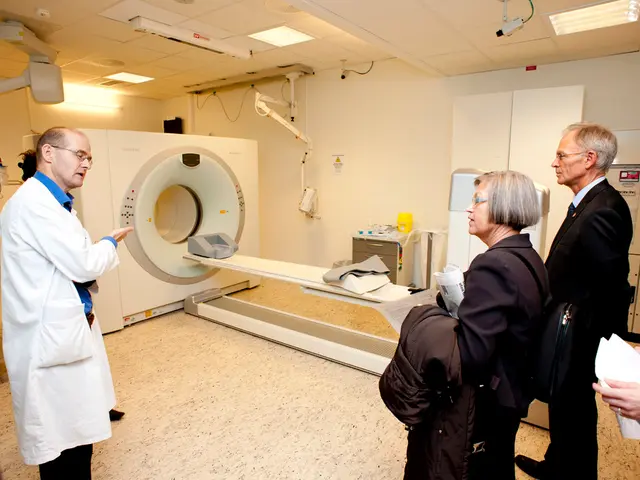White Mountains' Clean Air Achievement: A Notable Example of Air Quality Compliance Under the Clean Air Act
Gone are the smoggy days in the White Mountains: Hikers today enjoy clearer skies and improved health thanks to legislation like the Clean Air Act and the hiking community's advocacy through the Appalachian Mountain Club (AMC).
Fifty years ago, Congress passed the Clean Air Act (CAA) – arguably the most critical piece of environmental legislation to date. The law established emissions standards for vehicles and industrial factories, eliminating harmful pollutants in urban areas and high above sea level.
Over the past two decades, Georgia Murray, AMC's staff scientist, has been studying air quality in the White Mountains. In an interview, she discusses the changes observed and the role the Clean Air Act played. Spoiler alert: air quality and visibility in the White Mountain National Forest have both improved dramatically, and AMC has been involved since nearly the beginning.
If you took a hike in the White Mountains a few decades ago...
...you might've seen hazy skies from mountain peaks, obscuring views. You'd likely experience higher ozone levels on certain days. Ozone may not be visible itself, but it combines with fine particulates to create smog.
What caused these issues?
Pollution from smokestacks and tailpipes. In past decades, coal burning was widespread in the Midwest, with emissions traveling to higher altitudes and affecting the White Mountains. Ground-level ozone, along with auto emissions along the eastern seaboard, could, on a hot day, combine and form smog that traveled to the mountains.
The weather plays a crucial role in how these pollutants reach the White Mountains. On hot, humid days, weather often comes from the hazy Midwest or the Northeastern corridor urban areas. Ozone forms in the atmosphere when nitrogen oxides and volatile organic compounds are heated up, especially during periods of high pressure that last for a few days. These high-pressure systems can cause stagnant air, allowing pollution to build and be transported at night. Ozone is highly reactive, dissipating when it hits surfaces, but up in the White Mountains, there's nothing for it to collide with until it hits the higher peaks like Mount Washington.
Decades ago, acid rain affected the White Mountains due to emissions coming from western states.
How has this impacted hikers?
On a high-ozone day, you may feel a burning sensation or difficulty breathing. In 2002, there was a major ozone event in the White Mountains, and some hikers required oxygen treatment on Mount Washington. Chronic ozone exposure is of greater concern today, affecting people with respiratory diseases.
Families planning their entire summer around a trip to the White Mountains could be disappointed if they arrived on a day with poor air quality, making it hard to enjoy the stunning mountain views or causing health issues for those with asthma. AMC's hiker health study found even healthy hikers can be affected by air pollution in the mountains, with their lung function decreasing on high-ozone days.
What was the Clean Air Act, and how did it change things in the mountains?
The Clean Air Act is a bipartisan law that lays the foundation for essential clean air policies protecting human health and the environment from the harms of outdoor air pollution. The law addresses issues like measuring air pollution levels, setting health standards, reducing emissions from power plants and automobiles, and restoring Wilderness areas. AMC works on all these issues to protect humans, the environment, and wilderness.
Recognizing that visibility was being affected by air emissions, the CAA aimed to address these issues from the start. Still, the science took time to develop, and it was 1999 before the EPA implemented the Regional Haze Rule, detailing which pollutants needed to be reduced, how states could reduce those emissions, and how to track progress towards improving visibility. Since the rule's implementation and emission controls, the White Mountains have seen improved visibility.
Each state has a plan for managing air pollution, addressing emissions locally, but some states like those in the Midwest and along the eastern seaboard also receive transported pollution.
Acid rain is another area where AMC focused its efforts over the years. Recognizing sulfur as a harmful pollutant, the CAA led to the Acid Rain Amendment in 1990, with implementation beginning in 1995. Since 1990, sulfur dioxide emissions have been reduced by 1.5 million tons – a 91% reduction, according to an EPA progress report.
In the White Mountains, we have witnessed significant progress in reducing acid rain, ozone, and improving visibility. The CAA has been instrumental in this improvement, and it can continue to be effective if enforced and interpreted strongly. Despite the success of the CAA, there's a clear understanding that addressing greenhouse gases is crucial for our environment, health, and future. The same successful tool, the CAA, should be used to address climate change.
AMC's Role in the Work:
In the 1980s, AMC began monitoring acid rain and clouds in the White Mountains. Partnering with scientists from the U.S. Forest Service Hubbard Brook Experimental Research Station in the White Mountain National Forest, we researched regional cloud and fog water chemistry. The Lakes of the Clouds hut provided an ideal location for collecting clouds, and AMC staff has continued monitoring annually.
In the mid-1980s, the organization also began tracking ozone in collaboration with researchers from the Harvard School of Public Health. Little information had been collected on ozone levels in the northeastern mountains at that time, but our data demonstrated that high concentrations of ozone were being transported to Mount Washington and sometimes were as unhealthy as urban air. However, nearby in Pinkham Notch, at the base of the Auto Road, the levels were not as high. In 1990, AMC collaborated with the state of New Hampshire and the White Mountain National Forest to track and report air quality, eventually encouraging New Hampshire to add a high-elevation regional forecast when they issue air quality alerts.
AMC has been studying fine particles since 1987 and has captured data at upper elevations where few were observing. The levels we saw when I first started in 2000 could reach concentrations of concern for the health standard, but the visibility impacts were most severe. Now, the science around particulates has evolved, and we know that even low levels are unhealthy. The good news is that levels have decreased, and views have become clearer.
Finally, we're monitoring stream chemistry at upper elevations and at wilderness boundary sites. AMC is gathering baseline information about acid rain's impact on wilderness watersheds specifically, funded by a cooperative agreement with the U.S. Forest Service for baseline monitoring.
Since the clean air regulations came into place in the 1970s, AMC air quality monitors in the White Mountains have observed a decline in ozone levels.
Signs of the Clean Air Act's Success:
One key indicator of success is strong adherence to health standards. Currently, we are meeting the current ozone health standard, but science suggests it should be stricter. Any substance that causes human health issues, like ozone, should remain on a downward trajectory. We must ensure that science is front and center in the CAA's implementation to maintain the progress made in cleaner air and healthier conditions for hikers.
Success will also be in understanding the recovery process. For example, we're observing more organic carbon coming out of the mountain streams and ponds. Understanding the science around upper elevation sites as it relates to changing water quality and chemistry can only be done with continued monitoring. We know things have improved, but we need to learn how acid rain recovery will play out after decades of impact, as well as how other factors like climate change affect the area.
What can we do to see the mountain air and waters become cleaner?
By ensuring that science remains central to the CAA's implementation, and that protections aren't rolled back. We need more science in the regulatory process than what we've seen recently, and we must work to maintain and strengthen the clean air protections that have been developed over the past few decades. AMC continues to advocate for the protection of clean air, clean water, and wilderness for future generations.
- The Clean Air Act (CAA), a bipartisan law critical to environmental legislation, established emissions standards for vehicles and industrial factories, reducing harmful pollutants that used to cause smog and affect the air quality in the White Mountains.
- AMC's staff scientist, Georgia Murray, has observed significant improvements in air quality and visibility in the White Mountains over the past two decades, crediting this progress to the CAA and its driven implementation.
- Despite the Clean Air Act's successes, a concern remains regarding the impact of climate change on health and environmental factors, which currently requires the same successful approach to regulation and policy-making.
- Through collaborative research with various organizations and monitoring programs, AMC continues to support the ongoing efforts in protecting clean air, clean water, and ensuring the well-being of future generations in the White Mountains and beyond.







